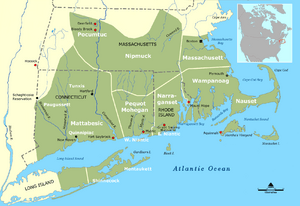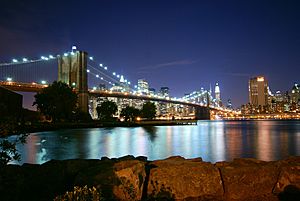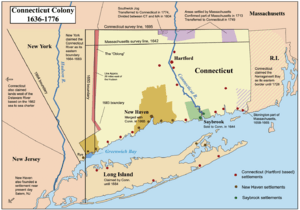History of Long Island facts for kids
Long Island has a long and interesting history, starting from the first European settlers in the 1600s. In the 1800s, new railroads helped it grow. More people visited for fun, and towns became some of the first modern suburbs in the United States.
Contents
Long Island's First People: Native Americans
When Europeans first arrived, the Lenape people lived on the western part of Long Island. They spoke a language called Munsee, part of the Algonquian family. In 1524, Giovanni da Verrazzano was the first European to meet these people in what is now New York Bay.
The eastern part of the island was home to people who spoke a language related to the Mohegan, Montauk, and Narragansett tribes. These groups were connected to Native Americans in Connecticut and Rhode Island. Long Island was important for making Wampum, which are beads made from shells.

Later, a person named Silas Wood wrongly claimed there were many different "tribes" on Long Island. He called them the Metoac, but this word has no real Native American meaning. Today, we know there were two main language groups, not 13 tribes. The Montaukett, Unkechaug, and Shinnecock nations, who are tied to the original people, still live on the island today.
A Native American name for Long Island is Paumanok. This means "The Island that Pays Tribute." Stronger tribes nearby often made the peaceful Long Islanders pay them to avoid attacks.
Early European Settlements
Dutch and English Beginnings
The western part of Long Island was settled by the Dutch, who called it Lange Eylant. They also started settlements in the 1600s on what are now Manhattan and Staten Island.
In 1636, Charles I of England ordered that Long Island be given to William Alexander, 1st Earl of Stirling. An agent for Alexander then sold most of the eastern island to the New Haven and Connecticut colonies.
Lion Gardiner was the first English settler. He made his home on Gardiners Island in 1637.
English settlements in the east began soon after. In 1640, Puritans from New Haven, Connecticut, arrived in what is now Southold. They bought the land from the Corchaug Indian tribe. Also in 1640, settlers from Lynn, Massachusetts, founded Southampton. They bought land from the local Shinnecock Indian Nation. The Dutch in New Netherland did not try to remove the English from these far-off places right away.
Southold was part of New Haven until 1662, and then Connecticut until 1674. When the English gave New York to the Dutch in 1673, the eastern towns refused to join the Dutch. They fought back with help from Connecticut.
When New York became English again in 1674, these eastern towns wanted to stay part of Connecticut. But the Duke of York's government made them join New York by 1676. This was because the Duke of York held a grudge against New Haven.
Long Island became home to three of the first twelve counties of the English Province of New York in 1683. These were Kings, Queens, and Suffolk counties.
The Revolutionary War on Long Island
The Battle of Long Island was the biggest battle of the American Revolutionary War. It took place in Kings County, which is now Brooklyn. For most of the war, the King's forces controlled Long Island. Soldiers stayed in local homes, and families had to provide them with food and beds.
In Oyster Bay, Major John André visited Raynham Hall. This was the home of Robert Townsend, one of George Washington's spies. Family stories say that Robert's sister, Sally, overheard André talking about Benedict Arnold's plan to betray West Point.
Colonists often raided Long Island during the war, usually using small boats called whaleboats from Connecticut. A famous raid was the Meigs Raid in 1777 at Sag Harbor.
Long Island in the 1800s
In the 1800s, Long Island was mostly farmland. But suburban growth began when steam ferries made it easy for people from Wall Street to live in Brooklyn Heights.
The Long Island Rail Road started in 1836. It connected Brooklyn to Jamaica in Queens, and by 1844, it reached the east end of Long Island. Other train lines went to Coney Island, the Rockaways, and Long Beach, serving beach towns. These growing railroads opened many stations, helping the island become more suburban.
From 1830 to 1930, the population of Long Island doubled about every twenty years. Cities like Brooklyn and Long Island City were formed.
By the late 1800s, Long Island became a popular summer spot for New York City residents. Famous people like President Theodore Roosevelt had summer homes here, such as Sagamore Hill in Oyster Bay. Wealthy families like the Vanderbilts also built large mansions on the North Shore, known as the Gold Coast.

Before the Brooklyn Bridge was finished in 1883, the only way to get to Long Island from the rest of the U.S. was by boat. More bridges and tunnels were built later, and the island became more suburban as its population grew.
On January 1, 1898, Kings County and parts of Queens became part of The City of Greater New York. The eastern part of Queens County, which was not included, became a new county in 1899. It was named Nassau County.
Slavery on Long Island
Black people have been a part of Long Island's history for a long time. Many first arrived as slaves before the American Revolution. They worked in homes and on farms. New York and Long Island had slavery until laws were passed in 1799 to slowly end it. The last slaves were freed by 1827. Most freed people stayed near where they had lived.
In the Northern states, slavery was less common than in the South. On Long Island, farmers might own a few slaves who often lived closely with the family. After the Civil War, tensions grew as freed black people and immigrants looked for jobs. Many African Americans later moved to industrial cities like New York City.
Long Island's Growth in the 1900s
In the early 1900s, new elevated trains and subways helped people commute to Manhattan jobs from Queens and eastern Brooklyn. These areas offered cheaper and larger homes. Seven new bridges were built across the East River, making travel easier. Immigrants from Southern and Eastern Europe moved to Long Island, making it a very diverse place. Their children and grandchildren often moved further east on the island.
In 1908, the Long Island Motor Parkway opened. This was one of the first limited-access highways in the world. It went from Queens to Lake Ronkonkoma.
In the 1920s and 1930s, Long Island began to change from farms to the modern American suburb. Robert Moses, who led the Long Island State Park Commission, built parkways and state parks across the island. Jones Beach became very famous. Long Island quickly became a getaway for New York City residents. Development then followed the parkways and train lines.
After World War II, Long Island's population grew very quickly, especially in Nassau County and western Suffolk County. Many people who worked in New York City moved to new housing developments built after the war. The most famous was Levittown. It was the first place where a builder constructed many similar houses close together. This gave returning soldiers a great chance to start families.
After Levittown's success, other areas also developed quickly. Nassau County became more crowded than Suffolk County. In the late 1960s, areas in Suffolk County like Deer Park and Commack also saw fast growth. As you drive further east, houses and buildings spread out, and you can still see some farms.
Long Island in the 2000s
Long Island and 9/11
Many Long Island residents lost loved ones in the September 11, 2001 attacks on the World Trade Center. A large number of people from the island travel to Manhattan for work every day. After the attacks, many victims' cars remained parked at train stations, showing how deeply the tragedy affected the community.
Nearly 500 Long Island residents died in the 9/11 attacks. Almost all of Long Island's volunteer fire departments helped the New York City Fire Department at Ground Zero. They helped with evacuations and provided firefighting support. Because the weather was very clear, many people in Eastern Long Island could see the huge smoke clouds from the World Trade Center for days.
Aviation History on Long Island
Long Island has played a big role in the history of flying. Roosevelt Airfield was built in 1916 in Garden City. From this airport, Charles Lindbergh started his famous nonstop flight to Paris in 1927. Roosevelt Airfield closed in 1951. Its land is now used for a shopping mall, Hofstra University, and homes.
Long Island was also home to major aerospace companies. Republic Aviation in Farmingdale made the famous P-47 fighter plane during World War II. Grumman Aircraft, with locations in Bethpage and Calverton, built the F-14 U.S. Navy fighter in the 1970s and 1980s. Grumman was also the main company that built the Apollo Lunar Module, which landed astronauts on the moon. They built 13 lunar modules. One is on display at the Cradle of Aviation Museum.
Another important airport was Floyd Bennett Field in Brooklyn. Opened in 1931, it was New York City's first commercial airport. Famous pilots like Amelia Earhart and Howard Hughes started or ended flights there. It later became a Naval Air Station and is now part of Gateway National Recreation Area.
Two of New York City's main airports, LaGuardia Airport (opened 1939) and John F. Kennedy International Airport (opened 1948), are on Long Island. There have been several plane crashes nearby. In 1965, Eastern Airlines Flight 663 crashed into Jones Beach State Park. In 1990, Avianca Flight 52 crashed in Cove Neck, killing 73 people. In 1996, TWA Flight 800 exploded over the water near East Moriches, killing 230 people. A monument to those lost stands at Smith Point County Park on Fire Island.
In 2012, Representative Carolyn McCarthy introduced a bill called the Long Island Aviation History Act. This bill asked the National Park Service to study ways to remember and protect Long Island's aviation history. This includes possibly making parts of Long Island National Historic Sites.



